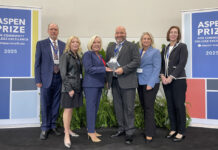HANCEVILLE, Ala. — Faculty and staff of Wallace State Community College recently met with industry partners and Society for Manufacturing Engineers (SME) staff to start a three-year project aimed at increasing the manufacturing workforce in the United States.
SME is a national nonprofit committed to accelerating new manufacturing technology adoption and building North America’s manufacturing talent and capabilities. The meeting was a kick-off to SME’s Manufacturing Imperative Workforce Pipeline Challenge (MI-WPC) to discuss strengths and challenges in addressing the industry’s workforce shortage and skills gap crisis.
“We are excited to lead Alabama in this nationwide effort to provide the manufacturing workforce with qualified and well-trained employees,” said Dr. Vicki Karolewics, president of Wallace State Community College. “Community Colleges have always been and continue to be a proven source for employees for business and industry, and we are honored to be part of this project.”
“Wallace State is committed to creating relationships with local industries that offer our students a pathway to jobs in those fields,” said Jerry Murks, dean of Applied Technologies at Wallace State. “We hope through participating in this project that we can share our best practices and make improvements using proven methods from other institutions and industries across the U.S.”
Wallace State is one of only 25 community colleges across the United States chosen to participate in the challenge.
“Wallace State was the first college in the state to be chosen by SME to participate in the challenge,” said Dr. Deb Volzer, government and workforce partnerships director for SME, who is leading the MI-WPC initiative. “There is innovation and excellence across the board, and the fact that you were on our short list and one of our first schools is cause for congratulations.”
The goal of the challenge is to attract 1,000 individuals at each of the initial participating community and technical colleges annually, resulting in 75,000 or more qualified workers in pursuit of manufacturing careers. The estimated economic impact of growing the industry’s workforce is an estimated $6 billion.
The challenge has garnered the interest of the White House, Volzer said.
“We are tapped as innovators and really aligned to their manufacturing Sprint Initiative,” she said. “So not only are you being highlighted in SME’s work, but you’re being highlighted at the highest level of the nation.”
SME started out 90 years ago with the goal of advancing technology and resources that bring profitability, innovation and new technologies into manufacturing and provide trained workforce.
Volzer said they chose to work with community colleges like Wallace State in this challenge because they are the “workforce engines of our country.”
She added that the manufacturing industry is facing some incredible headwinds, that were only exacerbated with COVID.
“We have about 8 million individuals aged 18-24 who have no plans for postsecondary after graduation from high school, if they graduate from high school,” Volzer said. “That’s a huge population that is sitting on the sideline not having a clear path of what they want to do. That is the workforce of the future, and we’re leaving them behind.”
Couple that with reports indicating there are 2.7 million jobs anticipated to go unfilled in manufacturing alone and the problem gets bigger, she said.
If nothing is done, there could be a $4 trillion impact on the economy, Volzer added.
“Think about manufacturing,” Volzer said. “It is absolutely the engine, at least a significant engine of our country. It’s our global competitiveness. It’s our economic resiliency and it is our national security.”
Additionally, Volzer said there are 35 million people who are interested in additional education and training.
“This whole experiment over the next three years is how do we amplify, accelerate and scale what you guys are doing well and how do we reach those 35 million people,” Volzer said.
Innovative solutions for attracting students in STEM related programs, developing and deploying curriculum aligned to the needs of local industry, changing the narrative around manufacturing, and deploying strategies to build stronger relationships with school districts will be shared nationally to grow local economies, reduce barriers to employment, and fill vacant manufacturing jobs.



















